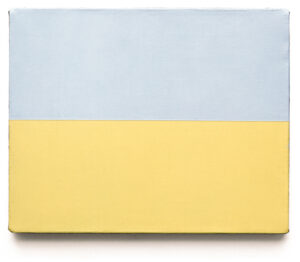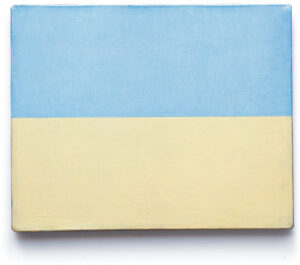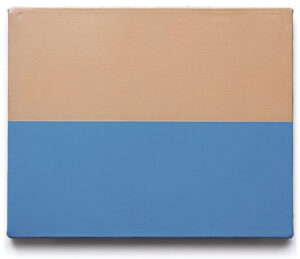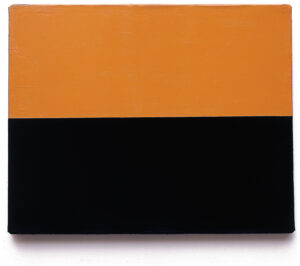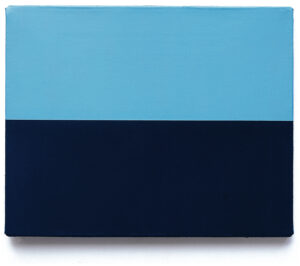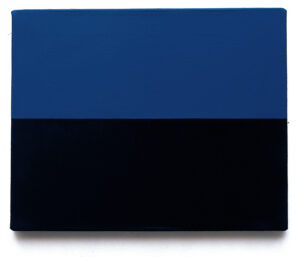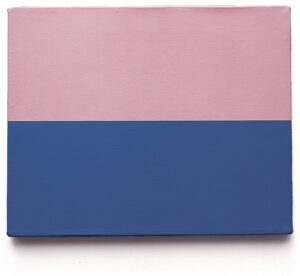. .’I breathed deeply, I revelled in the vastness of the opened horizon, in the different atmosphere that seemed to vibrate with the toil of life, with the energy of an impeccable world. This sky and this sea were open to me. The girl was right – there was a sign, a call in them – something to which I responded with every fibre of my being. I let my eyes roam through space, like a man released from bonds who stretches his cramped limbs, runs, leaps, responds to the inspiring elation of freedom. “This is glorious!” I cried, and then I looked at the sinner by my side . He sat with his head sunk on his breast and said “Yes,” without raising his eyes, as if afraid to see writ large on the clear sky of the offing the reproach of his romantic conscience’. .
(Conrad, Joseph, 1857-1924. Lord Jim, Chapter 35)
U vremenu zahuktale i sveprisutne industrije ‘les imagesa’ -a, gdje sterilizacija autorovog koda (ili neuroze) stoji kao jedan od općih imperativa, Vanja Pagar nudi Odnose u savršeno ekološkoj ‘best buy’ konfekciji s kraja tisućljeća: zdravi Proizvod, nepresušan izvor konotacija, istovremeno i najjednostavniji, nešto kao rješenje za svakoga.
Preispitujući mogućnosti suvremenog poimanja odnosa, autor rezolutno degradira subjektivnost sadržaja. No, ne posve. Zapravo dovoljno da u žarištu izroni nešto poput ‘treće’ boje, koja je na slici sve osim nje same, baš kao i kod jednog prirodnog fenomena i vječnog motiva: obzora, koji je i sam zapravo iluzija, art of nature, ali i vidljiva carinska rampa na granici između prirode ljudskog poimanja i nezamislivog beskraja što nas zaokružuje.
Pred Odnosima nemamo izbora. Skrivajući sadržaj svoje umjetnosti, autor nas navodi na adekvatan odgovor: meditirajući nad Odnosima preuzeti ‘njegovu’ ulogu osmišljavanja i tako otvoriti put ka pročišćenijoj osobnoj estetici. Jer ‘sadržaj kojeg nema’ odnosno tanka crta između dviju boja-kakvog ga vidimo, nudi nešto kao kvalitetnu polugu, suptilni ključ za pokretanje onih mehanizama imaginacije što su prenatrpani stereotipnim slikama, prizorima i izgledanjima koja mediji s namjerom i svakodnevno plasiraju, i koja često primamo sa teško objašnjivim povjerenjem.
Na Pagarovim slikama dvije vidljive boje postaju jedan jedinstven i neodvojiv odnos, koji je praktično i oduvijek jedini zaista postojeći: jer i more i nebo što su postavljeni u odnos i sami su odnosi sastavljeni od više odnosa: slojevitih namaza morskih i nebeskih boja što nam opet konotiraju svaki ‘pojedini’ odnos-boju u tim prirodnim prostorima).
Tako je i u realnim odnosima: iako u našoj percepciji nemaju svoj specifičan oblik, i pogrešno je, ali se čini prirodno zamišljati ih kao nešto između dvaju posve odvojenih i autonomnih stvari ili bića ( ili boja). Sve postoji samo u odnosima, i Pagarovi ‘univerzalni pejsaži’ pomoći će da se toga sjetimo uvijek kada se naviknemo misliti da smo i sami nešto više od odnosa stvari oko nas.
Andrija Anković 1999.
At the times when overwhelming industry of ”les images” is on the run, where the sterilization of the author’s code (or the neurosis) is one of general imperatives, Vanja Pagar offers the relations in a perfect ”best buy” environmental collection of the end of the millennium. It is a genuine Product, and as an endless source of connotations, at the same time, it is the simplest, too, being something like a solution for everyone.
Reconsidering the possibility of modern understanding of relations, the author degrades resolutely the subjectivity of the content. Yet, he does not do it completely. This is just enough to let something like the ”third” color to emerge from the focus. It is the color that is in the painting everything but itself, exactly as with a natural phenomenon and eternal motive – the horizon, art of nature, but, also a visible customs ramp at the border crossing between human perception and unimaginable infinity surrounding us.
There is no choice before the relations. Conceiving the content of his art, the author leads us to an adequate answer: meditating over the relations assume ”his” role of a creator thus making the way towards purified personal aesthetics. Because ”the content that is not”, that is, the thin line between the two colors, as we see it, that offers something like a quality lever, a subtle key for starting those mechanisms of imagination that are jammed with stereotype images. They are sights and views used intentionally by media every day, which we often accept with a confidence difficult to explain. In Pagar’s paintings two visible colors become a unique inseparable relation. This has practically always been the only existing one.
For both the sea and the sky, them set in relation, connote every ”single” relation-color within those natural spaces. It is so even in actual relations: although in our perception they are not of a specific form, it is also wrong, but it seems natural to imagine them as something between two completely separated an autonomous things or beings (or colors). Everything exists only in relations, and Pagar’s ”universal landscapes” will help us remember that any time when we develop a habit of considering even ourselves to be something more than the relations between the things surrounding us.
Andrija Anković 1999
“The future has ceased to exist; the idle circle of traveling closes in the land that lies before us, beyond the horizon. Elsewhere begins here, we become what is unknown to us” (Paul Virilio)
H O R I Z O N
“Relations”are reminding on a renaissance question of the horizon, as a visual metaphor of the balance of human with its environment,but at the same time opening a possibility of its multiple appearance, multi-humanity (as another possibility of the avatars comompassion of many souls) at once, less archaeologically. Exhibited as it is, a serial of different time-disconnected sequences of the same difference, it is treating the gallery space as a location of experimental and hypothetical zero-space/zero-gravity, non-time, not even place in the meaning of the location, but a local laboratorial nothingness/ in which horizons are in a way tested, and established temporary, in a place based serial with a time dimension excluded, so forming impossible visibility of the multi-horizon.
And as I noted many times, the problem of the contemporary art is not any more why to abandon this exhibition space, but it is why to go back, and in which sense to reinvent its purpose. A laboratoric ideal space. Painting is the right media of the elemental analysis, in theory related to the Gadamer’s point of “past” required for the horizon defining, but even more to Virilio’s warnings on the”disappearance of the horizon in the digital age”.
The horizon, moreover, for itself carries a quality of the reestablishment in sequenced time exposal (as lightening), that would be here related to the position of the classical media in the contemporary age. Referring to a long theoretical discussion on of the “horizon” (from Aristotle’s “Meteorology” over Kant’s writings, Gadamer and Husserl’s introduction of this primarily visual metaphor for the explanation of the discourse, into theory, and finally Virilio’s notion of its disappearance), “Relations” are basically a conceptual work of art. The aproovement for this is related to the discussion on it that rose again in a global digital age, related to the speed problems, but as well can be mentioned one regarding a local political age of the Balkan, seen as different timed than the rest of the world, and provoking questions as; the line and territory of beyond, of the other, and the problem of criteria following from it. So, it asks for the lost measure, for the compassionate multi-horizons, phase and soft politics, a projections and modal scenario (all together as disentifies). Getting back to the definition of the horizon, Gadamer’s one can be taken as the widest “horizon is the range of vision that includes everything that can be seen from a particular vantage point” as it states both relativism raised from subjectivity, and partial perspective. Husserl wrote how the individuality, the meaning of an object does not originate in objects itself, but in the context, or the “horizon”. The ego-horizon, or what Heidegger names “being in the world”, depends on the supposition of the existence after it, other one.
L I N E
To define a line a slight misusage of the geometry can be done, stating there is a starting point, a dot, from which things move in various directions, that dot that is inexistence. The point of view, the standpoint, perspectives point, is only relatively existing and not existing at the same time. Questioning self; line, that is a first existence, is awareness that sorts up things temporarily as here existing and beyond it, that is not categorical in-existence, but a potence of it, as it is a potence of the existence. It is a territory of simply unknown, which cannot be either confirmed or denied, that cannot be tested or verified as crossing is not possible, since the line moves constantly.
According to Euclid and even his most criticizing rivals, line is a first criterion of division of existence, in terms of a local of the invisible one, the one beyond the line, no matter straight or a curved world appears. Existence is only in “according to”, and it is not only true for the digital era “what is not linked doesn’t exist”, but it ways always debatable for things not-registered to be existing, those that were not even hypothetically assumed as such. In some sense, the horizon is then unifying here-ness of perception and there-ness of imagination. It is visible line of limits of our existence. The horizon is, a the same time, a line-phenomenon of a pure light existence, or the Biblical first derived existence, or the first not-metaphysical, existence of the “stage” lights that would show all other beauties to visual beings. Still, it is existence that conditions physical perception, the quickest existence almost reaching instant acts of the supposed “beyond” existence. Shapes we see only because there is a visual condensation on the light in our eye’s cells; there are no lines or sharp edges we see at all. There is only a contour of existence of, again possible, beyond-existence in the undiscovered and unfinished space. There are, therefore, possible views of a “horizon”, but as Husserl noted, there are as well “horizons of possibilities”, between which is always possible that something does not possibly exist. Unreachable, it belongs to others; those are the only criteria of existence. For those reasons it is not possible to exist out of social, out of political, as dot does not exist, it is only supposed for the explanation case.
Descartes cogito ergo sum (I think, therefore I am) resides on the past evidence and future expectations of the others, but as well on Genius Malignus as the only temporary otherness of this mind experiment. Line forms a territory, as light does, as well, defining borders and limits /of the instant/. Line therefore gives a first rule of the world. Those are rules of here and there, me and else, others and mine. Politics of the border, temporary and spatially runs a world, less and less meaning a conquering space, but arriving to the more intrinsic sense, that has been there for always; of conquering (as giving shape, limiting a set) of the meaning / primarily of property /. Meanings are transformable, or nomadic, and nomads are sentenced on existence and not-existence at the same time, living in-between here and the unreachable there. Paul Virilio might best explain this; “The future has ceased to exist; the idle circle of traveling closes in the land that lies before us, beyond the horizon. Elsewhere begins here, we become what is unknown to us” And, considering time, it can be connected to the Gadamers attitude “Hence the horizon of the present cannot be formed without a past”. For the establishment of a temporal horizon, therefore, both parameters are needed; disappeared one and to be established one. For that reason Achilles movement does not exist, as precisely movement exists, otherwise it would be impossible to have movement, as it always kills a previous state, abandoned place and time.
The disappearance of a horizon, on which Virilio talks, is related to the line and light at the same time. Reaching speeds that are faster than the limit of the light, civilization enters to the territory of beyond the line that defines. The line is intriguing, it is a space itself of a different kind, of a longer kind through which all territories, all politicness is denied and established at the same time. They are denied, as one can arrive to any point on the same continent following the line of none’s territory. Lines of the political borders are all connected, while territories are not. They are disconnected, that is different from not connected.
C O L O R S
But, the horizon is ways always chronically disappearing and reestablishing, as it was always escaping defining through a movement. And even the speed of light would give the same problem that is spatial defining – the world can become instant but not whole at the same time to a limited being. All speeds can be, as Zeno argued, divided into phases, and the phase is a bordered territory, small temporal self-functioning zone, and ideal place of movement. It is a resting point, holding of the action, temporal death (picnolepsy) itself, it is a place where moved is immovable, and relative to own being. Those effects are repeating, more and more, not in a time of passing, but time of understanding of a limited being.
They are horizons’ reestablishment through nothingness, cleaning of all shapes only colors, only tones in pairs that are not binary, but balanced, that is not strict but switchable, transformable, that are sensitive on the condensation around the line of segregation and a touch. “Relations” are a computational first phase recombinants, mutants of binary elementaries, as colors that are not primer, that are not contrasted, but balanced into a first morpheme. Or, to put it differently, it is about the formation of the meaning on the territory of morphing (of sounds and signs), in it’s connecting sound in-between pronounced letters, the sound of living, breathing, balancing different vocals and consonants, in a painful temporal fusion of both dead and alive, of a zombie territory. Consequent is only aphasia, which is not a death of the communication, but a painful getting birth, extended delivery, powerful sound of a dying of a meaning of one to the other, and the moment of their Bothness, the only balancedstabile moment, or a temporal death of identity. Interested in the calming of the event and a territory of its new division
S E R I A L
Serial of paintings “Relations” is about that horizon through which things can reestablish in same difference, or different sameness. Involved sides are worth equal, they have a same simple value of only the color, and they are restricted on the political territory of the painting. Serial is the difference; it is a time of a life. Periodic, periods, sameness that can become different, second state, the other of the sameness being a mad and sane, being man and a woman, mother and a father, being now and then, here and there, or simply being absent and present, through a line of division and connection, the one that belongs to both, and therefore has a special kind of existence. Periodic in a nomadic world are only moving in circles, inside the locked space of here and there, yesterday and tomorrow, or always only in-between arrivals and departures. Because of it the horizon is endless, as all borders on this planet are, moving on the borderline there is never the arrival or departure.
The only possible horizon we may speak about is a horizon of the expectations on the arrival, a horizon of projections of the other on the same, and the border dividing, the borderline madness. Other believes in arrivals, while travelers only in a reaching a point of there, of the horizon, that is moving. None arrived at the place none is waiting, but they only reach it. Travel on the line never stops. And repeating is death of the only alive thingevent in-between deaths. There is certain live-death behavior of what is believed to be primarily alive, and inhabiting a territory of the death, that is not a pure truth. Consequently are not true all binary relations, of up and down, black and white, stronger and weaker, male and female, adulthood and childhood. Both-ness is neither of them; it is ideal death of both, an equilibrium, stasis. This quest is about this balance, temporal resolution, nonevent, non-content and non-form. It is a repeating phase, and because of it things appear as endless. Serial of paintings Relations, that can be turned upside down, put in the serial, but never recombined in primer phase relation, is modally endless. They are simple objects “given to the intuition” (Husserl) : those are open worlds, in which objects are not given yet. Finally, mentioning Husserl’s “relations” is a pure objectification of his visual metaphor of the world in a notion of “horizon”, that is constituted “to think of the object, albeit a unity of sense, as somehow given or present to the eye of institution.”
Being the only object, they are in-objective, there is only a horizon for it, there is only other imagined more, a subject, a public. In-between a painting functions as a division line of that imagination, a horizon for itself.
Ana Peraica, 1999
–
…” and that part of the exhibited paintings inspired by the sea around and the sky over the island of Vis were presented at the Understructures last year, appropriately titled Relations. The Relations are definitely the best part of the exhibition at he Galic Gallery. It is a smaller format cycle composed of relations between two purified horizontally positioned fields.
The works, as we said, were inspired by the relation between the colors of high seas and the sky that change in dependence with the amount of daylight. The idea of taking a motive of an abstract geometric shape (a piece of the sky and sea) and making it more abstract, is intriguing. In this case, namely, the connection with the motive, no matter how much it is simplified, cannot be discussed because the motive of high seas and the sky itself is a little abstract and inaccessible. Pagar’s Relations are meditative contemplation cleaned from the individual approach to such an extent that his part of work dealing with painting resembles room decorating. The surfaces are covered with color completely evenly, without any brush trace, therefore without any subjectivity.
However, if subjectivity is dismissed from the movement, it is not from the color. The relations like orange ”sky” and ”black” sea, point out leaving the motive and moving towards the spheres of spiritual, but subjective associations “…
Sandi Vidulic, 2000
